
a web page by Don Roberson |
 |
||
SUNBIRDS & SPIDERHUNTERS Nectariniidae |
||
|
||
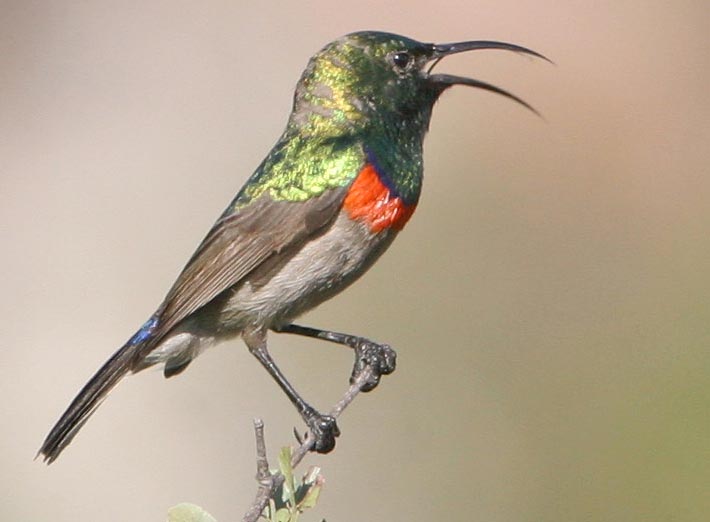 Sunbirds
are small jewels of the Old World tropics. Many species possess
glittering iridescent colors. In this feature, plus their small size
and their nectar feeding behavior, they recall the hummingbirds.
Sunbirds do hover at flowers but they don't fly backwards like
hummingbirds, and their flight behavior is much less complex than
hummingbirds. The centers of sunbird distribution are tropical Africa
and the forests of southeast Asia, including the Greater Sundas and the
Philippines. Some lovely examples include Metallic-winged Sunbird of the Philippines (male above) and Southern Double-collared Sunbird (male left) of southern Africa. Sunbirds
are small jewels of the Old World tropics. Many species possess
glittering iridescent colors. In this feature, plus their small size
and their nectar feeding behavior, they recall the hummingbirds.
Sunbirds do hover at flowers but they don't fly backwards like
hummingbirds, and their flight behavior is much less complex than
hummingbirds. The centers of sunbird distribution are tropical Africa
and the forests of southeast Asia, including the Greater Sundas and the
Philippines. Some lovely examples include Metallic-winged Sunbird of the Philippines (male above) and Southern Double-collared Sunbird (male left) of southern Africa. |
||
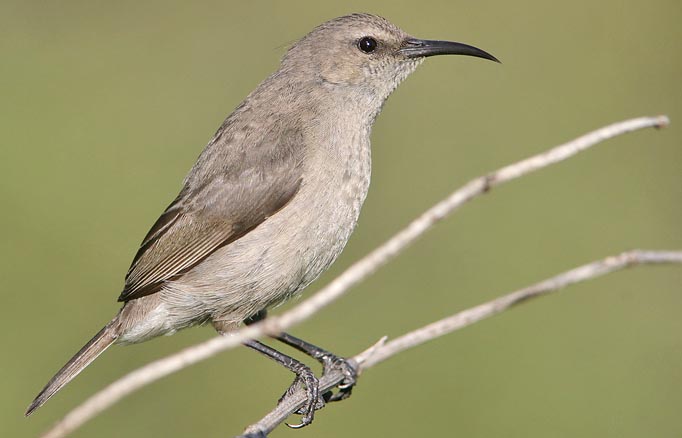 Ornithologists
have placed hummingbirds in over 100 genera, many of them monotypic,
emphasizing the wide diversity in bills, plumages and sizes. In
contrast, sunbirds are typically assigned to just 3-4 genera, plus a
dozen plus species of spiderhunters in the genus Arachnothera.
This has changed somewhat; revisions in Cheke et al. (2001) scattered
sunbirds over 15 genera, but still far less than hummingbirds. Except
for the spiderhunters, though, another feature than many sunbirds share
with many hummingbirds is pronounced sexual dimorphism. This sunbird
(right) is a female Southern Double-collared Sunbird, and was paired with the male shown just above. Ornithologists
have placed hummingbirds in over 100 genera, many of them monotypic,
emphasizing the wide diversity in bills, plumages and sizes. In
contrast, sunbirds are typically assigned to just 3-4 genera, plus a
dozen plus species of spiderhunters in the genus Arachnothera.
This has changed somewhat; revisions in Cheke et al. (2001) scattered
sunbirds over 15 genera, but still far less than hummingbirds. Except
for the spiderhunters, though, another feature than many sunbirds share
with many hummingbirds is pronounced sexual dimorphism. This sunbird
(right) is a female Southern Double-collared Sunbird, and was paired with the male shown just above. |
||
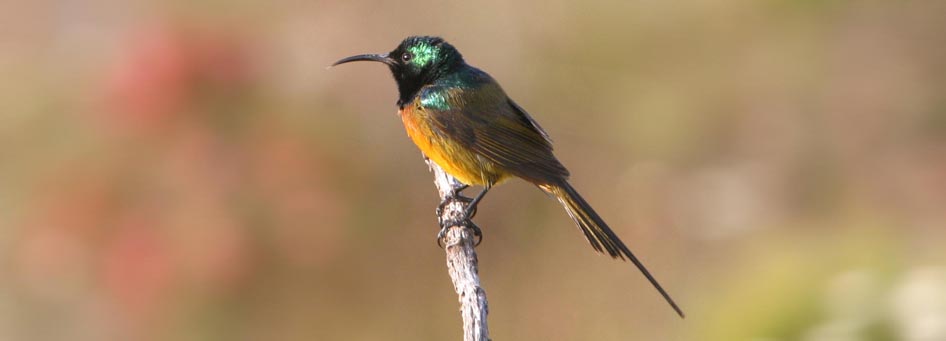 |
||
| Sunbirds grace a wide variety of habitats in the Old World, from lowland jungle to montane epiphytes, from flowering trees in open savanna or thornscrub to mangrove specialists. Wherever they are found, they brighten the birder's day. Orange-breasted Sunbird (above) is a long-tailed sunbird endemic to South African fynbos where it searches stands of Protea plants. White-breasted Sunbird (below left) has a patchy distribution in dry savanna woodlands from Tanzania and Congo to Kruger NP, eastern South Africa, where it works the flowers in car parks. Palestine Sunbird (below right) "is a very small, fat-bodied sunbird" occurring in "both dry open grasslands" and "rocky valleys and thick vegetation from sea-level to highlands" on the Arabian Peninsula (Cheke et al. 2001). | ||
|
||
 Sunbirds
can be at their most bewildering in central Africa, where one deals not
only with sexual dimorphism but regional differences. This Green-headed Sunbird
in Gabon (left) is actually BLUE-headed, not very green at all, as is
typical of the species in this part of its rather wide range [there is
another species, N. alinae, of montane forests of central
Africa which bears the name "Blue-headed Sunbird"]. At La Lopé
Reserve in Gabon, I tried to sort out the 14 sunbirds seen in this
vicinity of central Africa. These quotes are taken from my original
field notes (but generic assignment has changed since then, so some
genera stated here are now out-of-date). This was my attempt to sort
them out not only by color patterns, but by habitat and niche within
habitat (comments in brackets were added later): "Male Collared [Anthreptes collaris]
is short-billed" and has "lime green back & head, with blackish
band on chest above yellow belly." [This was the commonest sunbird at
forest edge at La Lopé & M'Passa reserves.] Inside the
forest, "Olive [Nectarinia olivacea] is common in canopy
flocks" where it is "large, dull, long-billed" and "sometimes shows
yellow [pectoral] tufts." [Probably the commonest sunbird inside the
forest at La Lopé & M'Passa reserves.] "Bates' [Nectarinia batesi]
is similar [to Olive] but is smaller & shorter-billed in canopy
flocks." [I was only satisfied with a single bird at La Lopé in
a canopy flock, but others had it daily there.] "Fraser's
(Scarlet-tufted) [Anthreptes fraseri] is yellow below &
looks warbler-like in canopy flocks -- fortunately I did see red tufts
on one of them." [This is an interior forest species.] Blue-throated
Brown Sunbird [Nectarinia cyanolaema] "is big & rangy
& long-billed & territorial on flowers in canopy of forest."
[Fairly common inside the forest]. "I've only seen a female
Green-throated [Nectarinia rubescens] (id'd by Patrice
Christy) but it was medium in all aspects, yellowish below with
distinct streaks, and thin prominent supercilium." Around the lodge at
La Lopé, Green-headed [Nectarinia verticalis] is a
mid-sized sunbird "in the garden; it is blue-headed in Gabon race with
flat mat-olive back" [The only ones I saw were in the lodge garden;
photo above.] The "dark coppery one at La Lopé" in the garden is
Copper Sunbird [Nectarinia cuprea]. "Male Carmelite [Nectarinia fuliginosa] is the really dark one at Libréville hotel & in La Lopé river scrub inland." "Olive-bellied [Nectarinia chloropygia] is in gardens & forest edge;" it is "small, short-billed, and green with red belly." Green Sunbird [Anthreptes rectirostris]
"is tiny, very short-billed, lime-green above and [on] head; thin band
on chest (looked grayish) and white belly" [seen in garden at
Libreville.] Down along the Ogooué River, "Violet-tailed [Anthreptes aurantium]
was restricted essentially to river "islands" or peninsulas; it is
"size of Collared & lemony below, but [has] rich violet reflections
to crown & upperparts." [It must be very restricted to immediate
riverine vegetation.] "Superb [Nectarinia superba] is along river and is black with violet crown/breast/rump & dark chestnut belly." "Reichenbach's [Nectarinia reichenbachii]
"is big & heavy & olive with blue-purple patches to crown &
chest, only narrowly connected at throat." [It is also fairly
restricted to riverine and shore habitats.] I passed my notes on to the
late Stuart Keith, and he incorporated some of them into the text of
Volume VI of The Birds of Africa (Fry & Keith 2000). Sunbirds
can be at their most bewildering in central Africa, where one deals not
only with sexual dimorphism but regional differences. This Green-headed Sunbird
in Gabon (left) is actually BLUE-headed, not very green at all, as is
typical of the species in this part of its rather wide range [there is
another species, N. alinae, of montane forests of central
Africa which bears the name "Blue-headed Sunbird"]. At La Lopé
Reserve in Gabon, I tried to sort out the 14 sunbirds seen in this
vicinity of central Africa. These quotes are taken from my original
field notes (but generic assignment has changed since then, so some
genera stated here are now out-of-date). This was my attempt to sort
them out not only by color patterns, but by habitat and niche within
habitat (comments in brackets were added later): "Male Collared [Anthreptes collaris]
is short-billed" and has "lime green back & head, with blackish
band on chest above yellow belly." [This was the commonest sunbird at
forest edge at La Lopé & M'Passa reserves.] Inside the
forest, "Olive [Nectarinia olivacea] is common in canopy
flocks" where it is "large, dull, long-billed" and "sometimes shows
yellow [pectoral] tufts." [Probably the commonest sunbird inside the
forest at La Lopé & M'Passa reserves.] "Bates' [Nectarinia batesi]
is similar [to Olive] but is smaller & shorter-billed in canopy
flocks." [I was only satisfied with a single bird at La Lopé in
a canopy flock, but others had it daily there.] "Fraser's
(Scarlet-tufted) [Anthreptes fraseri] is yellow below &
looks warbler-like in canopy flocks -- fortunately I did see red tufts
on one of them." [This is an interior forest species.] Blue-throated
Brown Sunbird [Nectarinia cyanolaema] "is big & rangy
& long-billed & territorial on flowers in canopy of forest."
[Fairly common inside the forest]. "I've only seen a female
Green-throated [Nectarinia rubescens] (id'd by Patrice
Christy) but it was medium in all aspects, yellowish below with
distinct streaks, and thin prominent supercilium." Around the lodge at
La Lopé, Green-headed [Nectarinia verticalis] is a
mid-sized sunbird "in the garden; it is blue-headed in Gabon race with
flat mat-olive back" [The only ones I saw were in the lodge garden;
photo above.] The "dark coppery one at La Lopé" in the garden is
Copper Sunbird [Nectarinia cuprea]. "Male Carmelite [Nectarinia fuliginosa] is the really dark one at Libréville hotel & in La Lopé river scrub inland." "Olive-bellied [Nectarinia chloropygia] is in gardens & forest edge;" it is "small, short-billed, and green with red belly." Green Sunbird [Anthreptes rectirostris]
"is tiny, very short-billed, lime-green above and [on] head; thin band
on chest (looked grayish) and white belly" [seen in garden at
Libreville.] Down along the Ogooué River, "Violet-tailed [Anthreptes aurantium]
was restricted essentially to river "islands" or peninsulas; it is
"size of Collared & lemony below, but [has] rich violet reflections
to crown & upperparts." [It must be very restricted to immediate
riverine vegetation.] "Superb [Nectarinia superba] is along river and is black with violet crown/breast/rump & dark chestnut belly." "Reichenbach's [Nectarinia reichenbachii]
"is big & heavy & olive with blue-purple patches to crown &
chest, only narrowly connected at throat." [It is also fairly
restricted to riverine and shore habitats.] I passed my notes on to the
late Stuart Keith, and he incorporated some of them into the text of
Volume VI of The Birds of Africa (Fry & Keith 2000). |
||
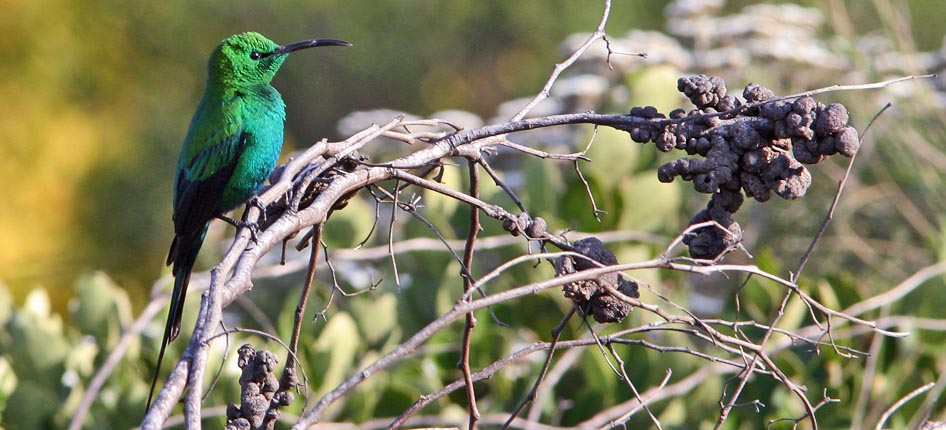 |
||
| The glittering-green and long-tailed Malachite Sunbird (above) is a specialist with a wide range of elevations. In South Africa it occurs at sea-level among the fynbos, and can seem to get 'lost' among the huge Protea flowers (below left). Yet in east Africa it is a highland specialist, frequenting Lobelia and Kniphofia and eating insects (and even small lizards) as well as nectar. They are on Mt. Kenya, Mt. Kilimanjaro, and other impressive peaks, but only above 1200m [4000'], or even 1600m [5200'] or 1800m [=5900'] elevation. | ||
Asian species run the gamut of widespread generalists, such as Purple Sunbird (below left) to island endemics, such as Handsome Sunbird (below right in a nice shot by Blake Matheson), which is endemic to the Philippines. It is closely related to Lovely Sunbird Aethopyga shelleyi, endemic to the Philippine island of Palawan, and the two were split as species very recently (Cheke & Mann 2008). Together they had been called "Shelley's Sunbird," but Handsome has a green crown while Lovely is blue-crowned. There are many island endemics among sunbirds from the Philippines to Wallacea. Many of the 19 species of the genus Aethopyga are island endemics. They tend to be small and short-billed, and include some of the brightest species in the world. Both species of Crimson Sunbird, and both species in the Handsome/Lovely Sunbird set, are among the Aethopyga. These sunbirds are typically restricted to forest habitats. |
||
|
||
|
||
The taxonomy of some sunbirds is still uncertain, but the phylogenic outlines of the family has taken shape (e.g., Cheke et al. 2001, Cheke & Mann (2008), and new information has brought much better focus to spiderhunters (Moyle et al. 2011). |
||
The 'typical' spiderhunters tend to be plain green, gray, brown, or streaked; only one — Whitehead's Spiderhunter Arachnothera juliae of the mountains of northern Borneo — is dramatic in plumage (contrasting black and white streaking and bright yellow rump). All spiderhunters possess long and decurved bills that they use to probe in the canopy or understory for spiders and insects. Yellow-eared Spiderhunter of the Malay Peninsula and Greater Sundas (left) is a mid-sized example of a typical spiderhunter.
|
||
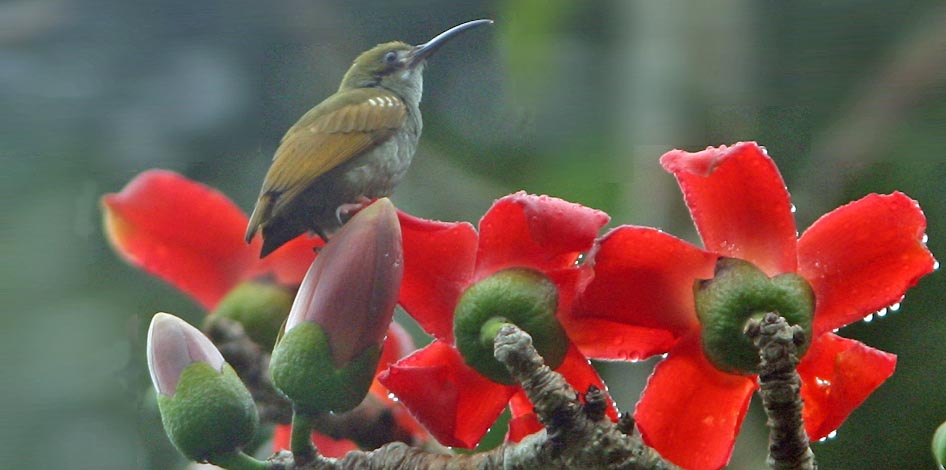 |
||
The Naked-faced Spiderhunter (above) is a large spiderhunter endemic to the Philippines. This photo was taken during a brief cloud-burst; the spiderhunter just sat motionless until the afternoon shower passed. Unlike most sunbirds, the sexes of spiderhunters are similar in appearance, and both sexes incubate eggs [in sunbirds, like hummingbirds, the gaudy males do not typically help in the breeding chores]. I suspect this Naked-faced Spiderhunter was in juvenal plumage. Not only was it less wary than most spiderhunters I've encountered, but note the white-fringed lesser wing-coverts. Cheke et al. (2001) and Cheke & Mann (2008) state that the juvenal plumage of this scarce species is "unknown" or "undescribed." |
||
Photos: The male Metallic-winged Sunbird Aethopyga pulcherrima was high up Mt. Pollis, Luzon, Philippines, in Dec 2005. Both male and female Southern Double-collared Sunbird Cinnyris chalybeus were at the escarpment viewpoint on Rte 27, near Calvinia, South Africa, in July 2005. The male Orange-breasted Sunbird Anthobaphes violacea was at Jonker Dam, not far from Cape Town, South Africa, on 2 July 2005. The male White-breasted Sunbird C. talatala (called "White-bellied Sunbird" in many South Africa books) was at Kruger Nat'l Park, South Africa, on 27 July 1996. The male Palestine Sunbird C. osea was photographed at Wadi Ammud, Israel, on 26 Oct 1981. The Green-headed Sunbird Cyanomitra verticalis was at La Lopé Reserve, Gabon, on 7 July 1996. The male Malachite Sunbird was near Cape Town, South Africa, on 2 July 2005; the second male in the Protea flowers was at nearby Kirshenbosch Gardens a couple of days later. The male Eastern Crimson Sunbird was at Dumago-Bone NP on Sulawesi, Indonesia, in 4 Oct 2011. The male Purple Sunbird C. asiaticus was in Corbett NP, India, in March 2001. Blake Matheson photographed the male Handsome Sunbird in the PICOP forest, Mindanao, Philippines, in Jan 2006. The male Olive-backed Sunbird C. jugularis aurora was on Palawan, Philippines, in Dec 2005, and the flying male of race plateni at Turbot, Sulawesi, Indonesia, in Sep 2011. The male Brown-throated Sunbird Anthreptes malacensis was at Tambon, Sulawesi, in Sep 2011. The Yellow-eared Spiderhunter Arachnothera chrysogenys was at Danum Valley, Sabah, Malaysia, in north Borneo, on x. The juv Naked-faced Spiderhunter A. clarae was on Mt. Makiling, Luzon, Philippines, in Jan 2006. All photos © Don Roberson, except Handsome Sunbird © Blake Matheson and used with permission; all rights reserved. Family book:
Literature cited:
|

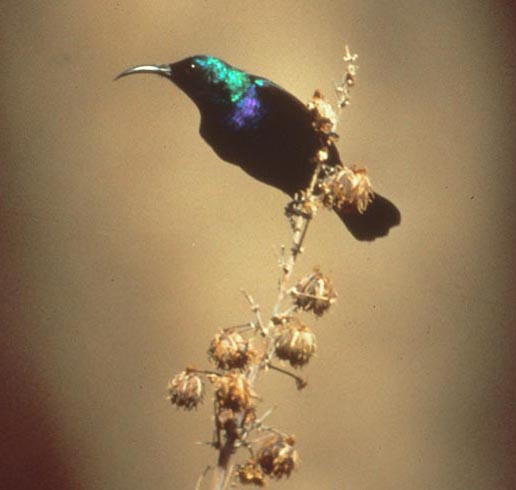
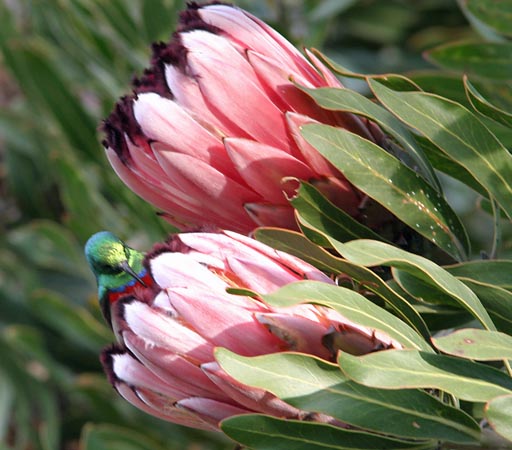 I should not give the impression that sunbirds are mostly African
birds. While it is true that ~64% of sunbird species are African —
including Madagascar and Indian Ocean sunbirds — some 36% (~49 species,
including all the spiderhunters) are from Asia. There are many beauties
among them, including Eastern Crimson Sunbird (below) — this aggressive male is raising its yellow rump feathers:
I should not give the impression that sunbirds are mostly African
birds. While it is true that ~64% of sunbird species are African —
including Madagascar and Indian Ocean sunbirds — some 36% (~49 species,
including all the spiderhunters) are from Asia. There are many beauties
among them, including Eastern Crimson Sunbird (below) — this aggressive male is raising its yellow rump feathers: 
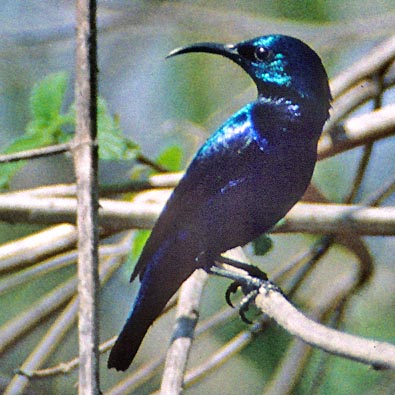

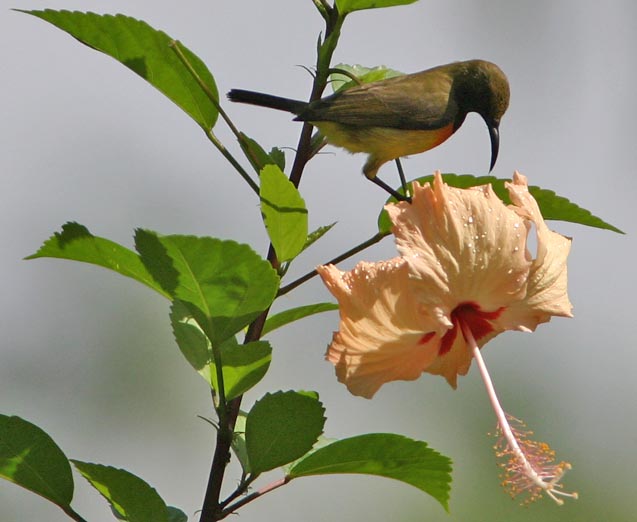 In contrast, Olive-backed Sunbird
(left) is a bird of open scrub, gardens, and lightly-wooded country,
and its range is wide, from southeast Asia to northeast Australia and
the Solomon Islands. However, with 22 named subspecies and much
variation, it may actually be a conglomeration of several sibling
species. This male (left) is of race aurora, confined to
Palawan and islands of the north Sulu Sea. It is characterized by a
bright orange band across the breast but a very plain face. Males of
race plateni (below, shown in flight), from Sulawesi, are entirely yellow-bellied but have prominent superciliary and moustachial stripes:
In contrast, Olive-backed Sunbird
(left) is a bird of open scrub, gardens, and lightly-wooded country,
and its range is wide, from southeast Asia to northeast Australia and
the Solomon Islands. However, with 22 named subspecies and much
variation, it may actually be a conglomeration of several sibling
species. This male (left) is of race aurora, confined to
Palawan and islands of the north Sulu Sea. It is characterized by a
bright orange band across the breast but a very plain face. Males of
race plateni (below, shown in flight), from Sulawesi, are entirely yellow-bellied but have prominent superciliary and moustachial stripes: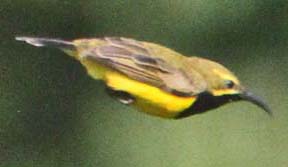
 Of course, not all sunbirds are gorgeous and glittering. Brown-throated Sunbird
(right) is also a generalist — forest edges, mangroves, scrub, coconut
plantations, gardens — with a wide range from southeast Asia to the
Philippines and Wallacea. Like Olive-backed Sunbird it has many named
subspecies (16; this one is celebensis of Sulawesi and
satellite islands). As it is rather plain in appearance, even males can
be overlooked as 'hard-to-identity' female sunbirds.
Of course, not all sunbirds are gorgeous and glittering. Brown-throated Sunbird
(right) is also a generalist — forest edges, mangroves, scrub, coconut
plantations, gardens — with a wide range from southeast Asia to the
Philippines and Wallacea. Like Olive-backed Sunbird it has many named
subspecies (16; this one is celebensis of Sulawesi and
satellite islands). As it is rather plain in appearance, even males can
be overlooked as 'hard-to-identity' female sunbirds.  With recent splits there are now 13 Asian spiderhunters, including Purple-naped "Sunbird" Hypogramma hypogrammicum
which become Purple-naped Spiderhunter. This unexpected finding was one
result of molecular studies by Moyle et al. (2011). Purple-naped
"Sunbird" was always an odd "sunbird" in southeast Asia — largish,
plain in appearance, and foraged in the understory on insects,
including taking spiders from their webs. It also has an unusual
tongue: "rolled at the edge to form two semi-tubes for much of its
length" (Cheke et al. 2001).
With recent splits there are now 13 Asian spiderhunters, including Purple-naped "Sunbird" Hypogramma hypogrammicum
which become Purple-naped Spiderhunter. This unexpected finding was one
result of molecular studies by Moyle et al. (2011). Purple-naped
"Sunbird" was always an odd "sunbird" in southeast Asia — largish,
plain in appearance, and foraged in the understory on insects,
including taking spiders from their webs. It also has an unusual
tongue: "rolled at the edge to form two semi-tubes for much of its
length" (Cheke et al. 2001). 